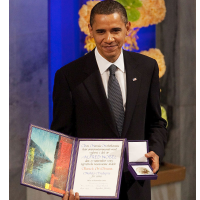Has U.S. Expanded Drone Use from Fighting anti-American Terrorists to Targeting Opponents of Friendly Foreign Governments?
 Barack Obama with Nobel Peace Prize (photo: Pete Souza, White House)
Barack Obama with Nobel Peace Prize (photo: Pete Souza, White House)
When Sen. Barack Obama was running for President in 2008, he frequently promised to “send in the drones” to fight terrorists in foreign lands. Having kept that promise by launching at least 1,510 drone strikes (1,160 in Afghanistan, more than 300 in Pakistan and 50 in Yemen) that killed about 2,500 people, 88 of them civilians, the 2009 Nobel Peace Prize winner now appears to be starting his second term by expanding their use—and arguably violating international law in the process.
When the U.S. first started using unmanned drones to attack terrorists on foreign soil, the administration of President George W. Bush fashioned the justification for doing so to adhere, at least loosely, to the post-9/11 Authorization to Use Military Force and principles of Article 51 of the UN Charter, which governs when one nation is allowed to use force against the people or territory of another. According to Dr. Micah Zenko, a national security expert at the Council on Foreign Relations, they did so by emphasizing that drone strikes would target terrorists who threatened the U.S. from afar, such as al-Qaeda.
Attacks on local insurgents who have no interest in attacking the U.S. homeland fall outside of that rationale and are potentially in violation of international law, since the U.S. has never stated a justification for them. Nevertheless, most of the people killed by drones are local insurgents trying to achieve purely local goals like imposing sharia law or unseating an “irreligious” government.
According to Peter Bergen of the New America Foundation, “militant leaders” of anti-U.S. groups like the Pakistani Taliban, the Afghan Taliban, or al-Qaeda, constituted only about 30% of those killed by drones under the Bush administration, and only 13% under Obama. The rest are local insurgents, as in Pakistan, where for two years most strikes have targeted militants fighting the Pakistani government or American troops in Afghanistan, says Zenko. Likewise in Yemen, local media reported that some strikes killed militants about to attack Yemeni military forces.
Although Zenko says “the marked shift was in summer 2008 when the Bush administration decided to significantly lower the threshold of who could be attacked,” by drone, Obama greatly expanded its use as he increased the number of drone strikes overall. Nevertheless, the Obama administration has thus far denied that anyone not a threat to the U.S. homeland—anyone falling outside the stated justification for targeted killings on foreign soil—is being attacked by the U.S.
At the same time, however, the administration is said to be engaged in a robust debate on re-fashioning the justification for target killing and drone strikes, especially in light of the fact that eventually, and probably sooner than the U.S. would prefer, other nations will develop their own drone technology. A world in which nations felt free to send unmanned drones to kill perceived threats anywhere in the world would be an insecure and chaotic one.
-Matt Bewig
To Learn More:
Have U.S. Drones Become a “Counterinsurgency Air Force” for Our Allies? (by Justin Elliott, Pro Publica)
Election Spurred a Move to Codify U.S. Drone Policy (by Scott Shane, New York Times)
- Top Stories
- Unusual News
- Where is the Money Going?
- Controversies
- U.S. and the World
- Appointments and Resignations
- Latest News
- What If China Invaded the United States?
- Donald Trump Has a Mental Health Problem and It Has a Name
- Trump Goes on Renaming Frenzy
- Trump Deports JD Vance and His Wife
- Trump Offers to Return Alaska to Russia






Comments